Mowing grass is hardly an art form, but having knowledge of the best methods of grass cutting will make the process simpler, quicker, and more efficient, and give you a tidy, healthy lawn.
Here, I’ve shared my top 8 lawn mowing tips so you can properly cut the grass in your garden.
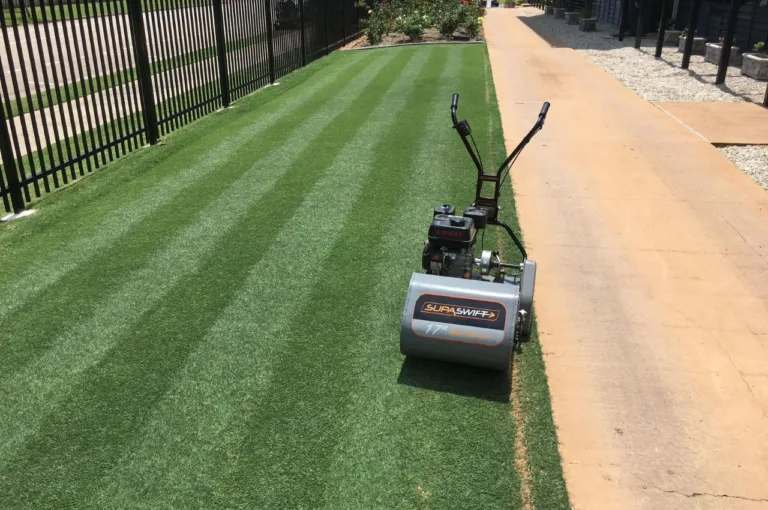
✅ Key Takeaways:
To cut grass properly, use a sharp mower blade, switch up your cutting pattern, mow at the right time of the day, and compost or spread the grass cuttings on your lawn.
The most efficient way to mow a lawn is to mow the outer edge of the lawn first, then mow vertically in straight lines.
Make sure to adjust the mowing height so you only cut one-third off the original grass height, and don’t mow too frequently (most lawns in the UK need cutting once fortnightly in early spring, then once weekly in late spring and summer).
Table of Contents
❓ How Do You Cut Grass Properly?
The proper way to cut grass is to cut around the perimeter before mowing in laps of the widest part of your lawn, and never cut more than one-third of the grass length in a single mowing session.
Cutting your grass in this manner will help you to maintain a healthy lawn and speed up the mowing process, so you can spend less time to achieve the same results.
🤔 What’s The Best Mowing Pattern?
The best mowing pattern is to mow around the perimeter of your lawn and around any large objects, then mow your lawn in back-and-forth laps starting at one corner and ending on the other side of your lawn.
Make sure you walk in laps of the widest part of your lawn to reduce the frequency of turns you will need to make at each end. Walk in a straight line, slightly overlapping the path that you took on your last lap.
The back-and-forth mowing pattern is the most efficient grass-cutting method for push lawn mowers, so it should save you time and reduce your likelihood of missing spots.
Brand: Bosch
Price: £
Power source: Electric corded
Cutting width: 32cm
Cut height range: 20-60mm
Weight: 6.8 kilograms
Grass box capacity: 31 litres
Dimensions (DxWxH): 35.5 x 6.5 x 6.5cm
Power: 1200 W
📆 What’s The Ideal Mowing Frequency?
The ideal mowing frequency for gardens in the UK is once every two weeks in early spring and once a week in late spring, summer, and early autumn.
The grass-growing season starts around mid-March, and grass will begin to grow slowly from this time onwards. Start cutting your grass when you notice that it has grown beyond its usual height.
Continue to cut your grass once a fortnight until mid-May onwards, when the damp conditions and warm weather will speed up the rate of grass growth. From May through late September, you’ll need to cut your grass more often; as frequently as once a week.
Keep track of your grass growth and don’t mow for the sake of mowing. Cutting your grass too frequently could be detrimental because it’ll stress the grass and increase the likelihood of disease.
Grass doesn’t grow during winter so you shouldn’t have to cut your lawn from October through early April.
I don’t recommend getting your mower out during these months because the wet, cold weather alters the soil structure, so you’re likely to leave muddy mower tracks. Plus, frost and damp can be damaging to a mower and potentially dangerous to the operator.

✅ How To Properly Cut Grass: My 8 Top Tips
Now you know the basics of good grass cutting techniques, read on to learn our top 8 tips on how to properly cut grass.
✂️ Make Sure Your Blade Is Sharp
One of the factors that most affects the quality of your lawn is the sharpness of your mower blades.
Dull mower blades tear grass, rather than providing a clean cut, which give your grass brown tips and increases the likelihood of diseases.
You’ll know if you have a dull blade on your mower because your lawn will have a tatty or uneven appearance after you’ve finished cutting.
You can make your mower blade sharp again with an at-home blade sharpening kit for less than £10. If you have chipped or blunt blades, you might need to buy a brand-new blade that’s compatible with your mower. New blades cost £10-£20 on average.
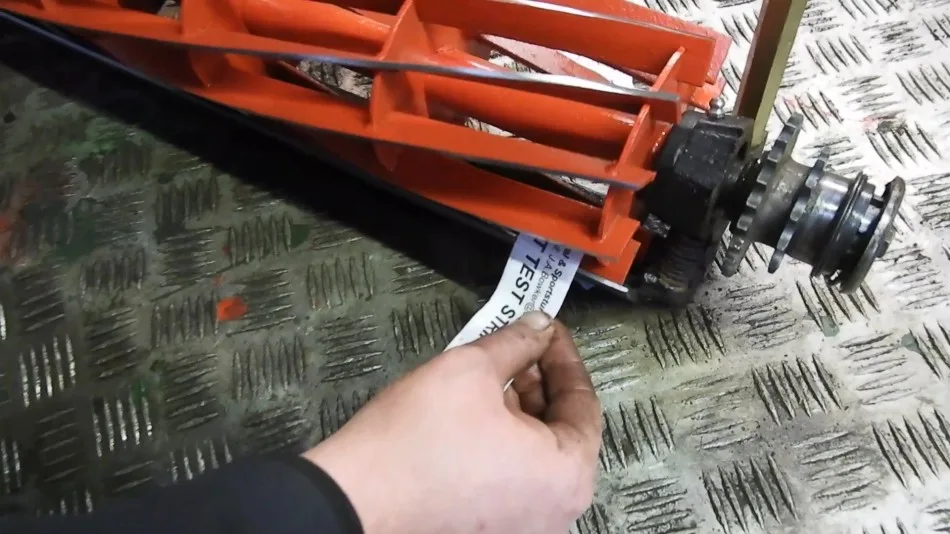
⏰ Mow Your Lawn At The Right Time
Most of us fall into one of two categories: we have a specific lawn-mowing schedule that suits our lifestyles, or we’re guilty of letting our grass grow long and cutting it when it’s starting to look overgrown. Neither of these are ideal scenarios for a healthy lawn.
Monitor your grass growth and learn how quickly your grass reaches optimal mowing height. Ideally, wait until your grass is between 5cm and 7cm tall before you cut it.
Keep in mind that different grass types grow at different speeds, so your own lawn might grow at a different rate from your neighbour’s, depending on your grass type.
A once-weekly cut is good to aim for during peak growing season, but use your common sense and mow when you feel is right.
🤏 Don’t Cut Your Grass Too Short
You might like the neat, manicured appearance of a closely-cropped lawn, but in normal mowing conditions, cutting your grass too short will stress the grass plants and leave them prone to disease.
Shorter grass also means fewer leaves, so the grass blades can’t synthesize as they want to, which influences future growth and may lead to a patchy lawn.
A good rule to follow is the one-third rule, which says that you shouldn’t cut more than a third off the original height of the grass in your mowing session.
So, if your lawn is 6cm tall, cut it to 4cm – no shorter. This will prevent stress to your grass from cutting away too much of the leaf.
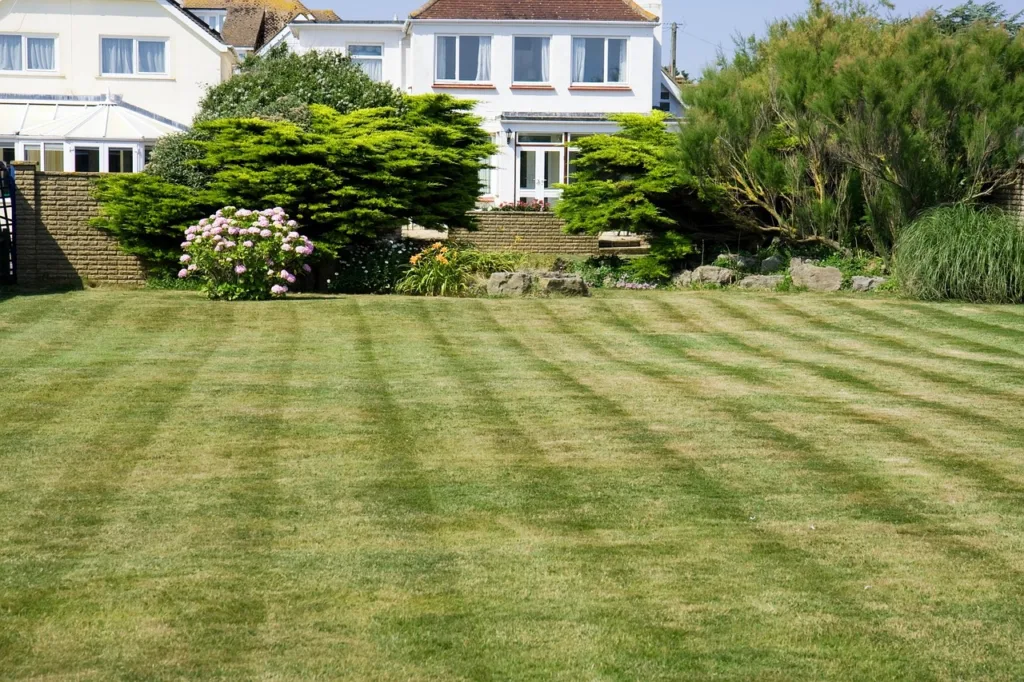
✔️ Mow At The Best Time Of The Day
We know that regular mowing is important – but is there a certain time of the day that’s best to get your mower out?
The best mowing times during the day are 9am to 11am, or between 4pm and 6pm.
Mowing within these times means you should avoid the morning dew, which could cause grass clumping and make your lawn mower work harder, and you’ll also avoid the hottest time of the day. Mowing before 6pm also means that the grass will have enough time to recover before the sun sets.
↩️ Switch Up Your Mowing Pattern
I’ve already mentioned the most efficient pattern for mowing your lawn, but you might want to switch this up from time to time.
Mowing in the same pattern could make grooves in your soil and ruin the appearance of your lawn, especially if you have a heavy mower.
You can avoid this by mowing in a different direction and pattern with each cut. That could mean mowing in horizontal stripes one week, then vertical stripes the next, the diagonal lines the next. You’ll lose some of your efficiency, but you’ll be able to maintain a cleaner lawn with no noticeable grooves.
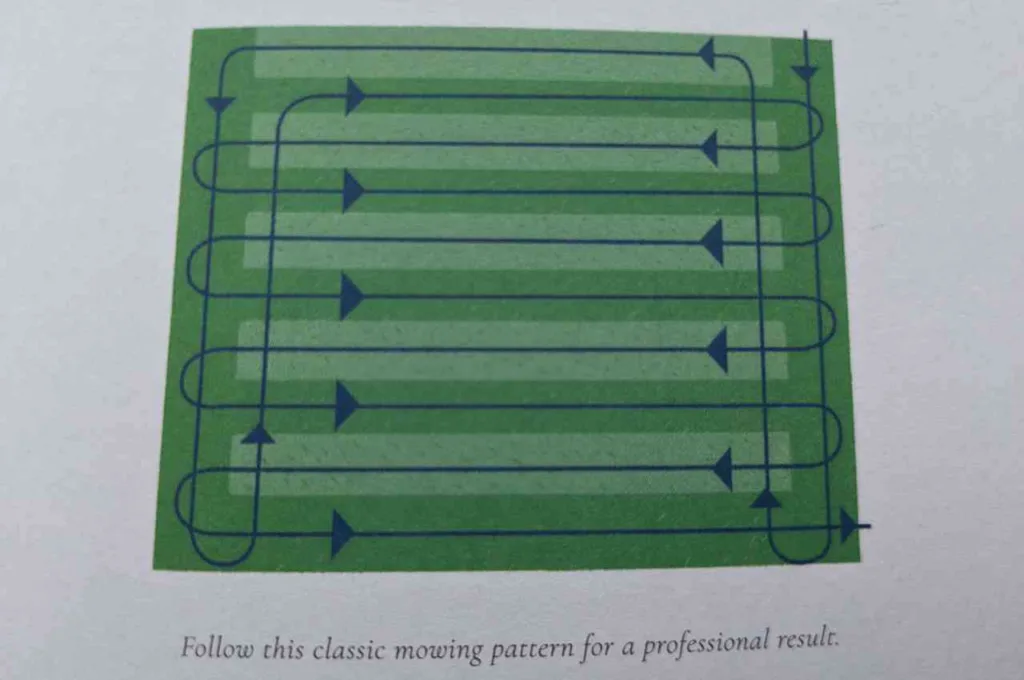
♻️ Consider Mulching
Mulching is when you disperse grass clippings over your lawn as you mow. This was originally thought to contribute to thatching, and some people don’t like the way it looks, so most of us bag and bin our cut grass blades rather than leaving them on the lawn.
However, I recommend mulching, especially if you have a lawn mower with a mulching function, because you now know that leaving lawn clippings on your grass is an organic fertiliation method that helps your grass to grow and control weed growth.
A mulching mower is the best choice because it chops grass blades into fine pieces, so they’re faster to decompose and won’t form clumps on your lawn.
🚴 Pace Yourself
It’s easy to get so caught up in trying to achieve the perfect lawn that you end up overexerting yourself.
If you have a moderate-to-large lawn, break the job into smaller sections. That might mean mowing one part of your lawn in the morning, and the other in the late afternoon, so you have a decent break in-between and avoid the hottest part of the day.
I recommend starting with the most time-consuming mowing spots, such as around rocks, trees, and other obstacles in your garden. It’s best to start with these challenges while you’re the most energized, and finish off with the easier back-and-forth mowing of the rest of your lawn.

🏁 Finish The Job Properly
You’ll probably agree that you haven’t mowed your lawn properly if you’ve left grass clippings on your paths and driveway.
After you finish mowing and you’ve cleaned your lawn mower and returned it to storage, spend some time sweeping or blowing the lawn waste back onto your lawn to supply it with beneficial nutrients. Alternatively, put the clippings on your compost pile, or into a big bag to go in your garden waste bin.
You’ll have the neatest end result when you’ve tidied up around your lawn, so try not to leave grass clippings where they shouldn’t be.
❌ Is There An Incorrect Way To Cut Grass?
There’s technically no incorrect way to cut grass. As long as you’re making your grass blades shorter, you’re doing a good enough job.
However, there are a few methods that I don’t recommend, simply because they won’t keep your grass healthy or looking its best.
A few “incorrect” mowing practices are:
Mowing wet grass, which will clog your mower deck and leave clumps on your lawn.
Mowing after the morning dew. Mowing in mid-morning or early evening is best.
Cutting off more than one third of the original grass height, which affects grass growth and prevents it from developing a deeper root system.
Mowing too frequently, which stresses the grass and causes it to turn yellow or brown.
Using dull mower blades, which tear the grass and increase the risk of disease.
Waiting too long between mowing. If you don’t mow as often as you should, then try to cut too much off the grass, it’ll lead to stress and potentially disease.
The reality is that it’s not always possible to avoid some of these practices.
For instance, if you lead a busy lifestyle, maybe Saturday mornings are the only time you can cut your grass, even if your grass isn’t quite ready to be cut.
Or maybe you end up mowing your lawn every three weeks, rather than every week, so your grass grows a bit longer than usual, and you ignore the one-third rule and cut it to over half its original height to avoid having to cut it again next week.
Of course, we all want to have a beautiful lawn that we can admire all summer long, but don’t be too obsessed with the end result. We all have lives around mowing our gardens, after all! It’s okay if you can’t follow all the best lawn mowing practices all of the time.
Remember also that most problems can be remedied by simply leaving your grass to regrow and using grass seed to fill in sparse areas if needed.
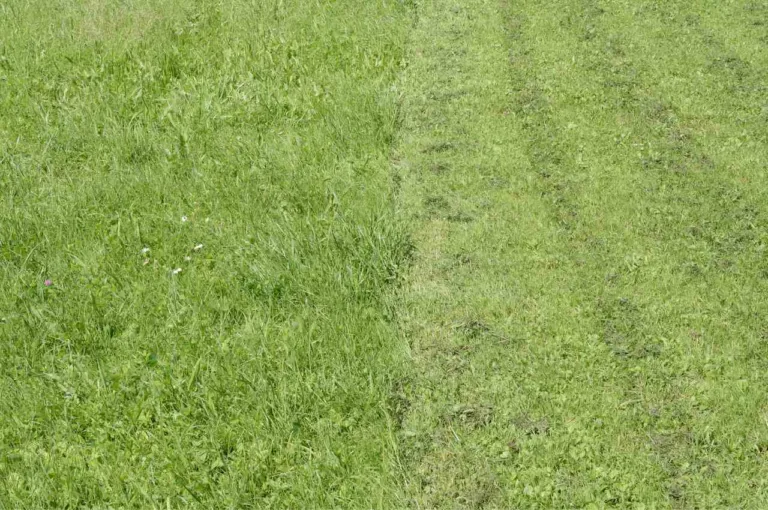
⁉️ FAQ
How much should I overlap when mowing?
You should aim to overlap your previous mowing path by 5-10 centimetres when you’re mowing back in the opposite direction on your next lap. That reduces your likelihood of missing parts and later discovering stripes of uncut grass.
Do you edge before or after mowing?
Most people edge before mowing because they prefer to get the most challenging part of the job done first and it gives them a border to mow to. However, you might personally prefer to mow in back-and-forth laps first, then finish with edging, and that’s fine too. It’s all down to personal preference.
What not to do when cutting grass?
There are a few things that you shouldn’t do when cutting your grass: don’t mow wet grass because it’ll clog your blades and smother the lawn; don’t mow with a dull blade because dull blades tear the ends off grass blades and increase the risk of disease; and don’t mow too low or too often because this could stress the grass and stunt its growth.
What time is best to mow the grass?
The best time to mow the lawn is between 9am and 11am, or between 4pm and 6pm. Mowing your lawn at any of these times means you can avoid the early morning due and the midday sun, so you can enjoy the best cutting conditions without overexerting yourself in the heat of the day.
Is it better to cut grass wet or dry?
It’s much better to cut dry grass than wet grass because wet grass will clog the mower and clump on your lawn rather than scattering evenly, and the weight of the lawn mower on the damp ground will leave ruts and smear the mud. Always wait for a dry spell before you mow a lawn, even if it means your grass growing a bit longer than usual.


